Coliseum agrees to rave moratorium
June 30, 2010
Los Angeles Memorial Coliseum officials have agreed to a call by Supervisor Zev Yaroslavsky, a member of the facility’s governing body, to impose a moratorium on future “raves” following the drug overdose death of a 15-year-old girl at a weekend event. A second girl remains hospitalized in critical condition.
Billed as the largest rave in North America, the Electric Daisy Carnival drew an estimated 185,000 participants. Roughly 120 concertgoers were taken to local hospitals for treatment, most of them for drug overdoses, intoxication, and related injuries.
Following a decision by Coliseum Commission President Barry Sanders to convene a special meeting on the matter, Yaroslavsky wrote to him proposing a moratorium on renting the historic facility “to any individual or company that promotes raves.”
“The general public deserves to be assured that when the Coliseum’s tenants stage an event, the health and safety of the promoter’s patrons are protected,” Yaroslavsky wrote. “Clearly, there was a breakdown at the Electric Daisy Carnival which put the public at risk.”
Sanders informed Yaroslavsky that he agreed with the proposal and planned to support it. In the meantime, he said he has ordered Coliseum management to immediately observe such a moratorium before the upcoming meeting, scheduled for July 16.
In recent decades, raves evolved from their underground origins as all-night electronic music dance events held in downtown lofts, surreptitiously promoted largely by flyers and word-of-mouth, into large-scale, widely advertised and highly commercialized events. Often used during these raves is the drug Ecstasy, or MDMA, an illegal synthetic methamphetamine and hallucinogen.
A recent article in the Morbidity and Mortality Weekly Report of the Centers for Disease Control examined the aftermath of a 2009 New Year’s Eve rave at the Coliseum, which sent 18 patients, aged 16-34, to local emergency rooms for Ecstasy overdoses. Ten of the patients had also been drinking, five had used other drugs, and three required hospitalization.
Posted 6/30/10
Sign of the times for L.A. cyclists
June 30, 2010
Shhh. The sharrows are here.
But don’t look for any big official explanation of the shared bicycle-automobile lanes that have started popping up over the past month on Los Angeles city streets. Although the topic’s been a hot one among local cycling activists and bloggers, city transportation officials say they are trying to keep a low profile for the pilot project until they can study how motorists react to the new lanes.
Even without officially-announced guidelines, people driving or biking over the new stenciled markings on L.A. streets will almost certainly notice they’re seeing something different on the road this summer. What’s less clear is whether they’ll know what the markings mean.
The sharrows—short for “shared-use arrows”—are not intended to replace bike lanes, but to provide a safe bike and car zone on streets that are too narrow for a dedicated bikes-only space. They’re meant to create a place for cyclists to ride out of the dreaded “door zone”—where a parked car door can open suddenly and knock a rider to the ground. Sharrows also remind motorists that the streets are for bicyclists’ use, too. The sharrows don’t change existing rules of the road; when passing a bicycle, motorists would continue to follow the guidance of the DMV driver handbook, which says: “Slow down and pass only when it is safe. Do not squeeze the bicyclist off the road.”
Sharrows are the latest visible sign of the bicyclization of Los Angeles—a movement that is gaining traction in a city known worldwide for its love of, and dependence on, cars.
Despite the stealth rollout, the sharrows’ arrival marks an important moment in L.A.’s transportation evolution, some bike activists say.
“Because L.A. has been historically—and still is—not bike-friendly, and is such a car culture, it really is saying, ‘Yes, we’re going to think about bikes now.’ It is the start of a turning point,” says Aurisha Smolarski, campaigns and communications director for the Los Angeles County Bicycle Coalition.
It’s a turning point that city transportation officials prefer not to discuss publicly until they can complete a study designed to evaluate motorists’ before-and-after behavior in the sharrows zones. The agency does, however, have an announcement about the new sharrows on its main website, with a link to a detailed story and pictures on its bike blog.
Smolarski’s organization, a nonprofit advocacy group that lobbied for the sharrows, has been charged with rolling out an educational effort in August or September, once the city Department of Transportation study is complete.
“Personally, I wish we could do it immediately,” Smolarski says. Instead, informative brochures must take a back seat to word-of-mouth communication for the moment.
(Meanwhile, Long Beach, which beat Los Angeles to the punch with its own sharrows, offers some neighborly help to navigating such lanes in this Q and A, posted under the headline “There’s a new sharrow in town.”)
L.A.’s first sharrows—also known as shared lane markings—were stenciled onto Fountain Avenue between Western and Vermont avenues on June 11. In addition to the coverage on the LADOT Bike Blog, the sharrows also drew the attention of KNBC, which televised this report.
After that, sharrows-sightings turned into something of a popular sport, with wags on Twitter likening it to celebrity-spotting after sharrows popped up on 4th Street between Wilton Place and Commonwealth Avenue.
Next up was Reseda Boulevard, where sharrows were stenciled between Vanowen and Valerio streets.
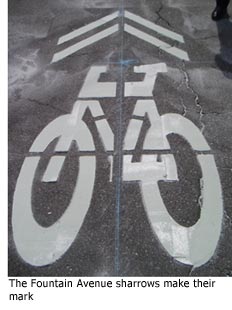 In all, six sharrows are planned for the pilot program. There’s no official word on where the others will be, but the LADOT Bike Blog has linked to the L.A. Eco-Village Blog for some information shared by a city bicycle advisory committee member on where the other sharrows are to be located, along with a Google map depiction.
In all, six sharrows are planned for the pilot program. There’s no official word on where the others will be, but the LADOT Bike Blog has linked to the L.A. Eco-Village Blog for some information shared by a city bicycle advisory committee member on where the other sharrows are to be located, along with a Google map depiction.
Sharrows have drawn kudos—and sometimes controversy—in other cities. Since they first were introduced in Denver in the mid-1990s, they’ve been used in Portland and San Francisco as well as a number of Southern California cities, including Glendale, Pasadena and Hermosa Beach, in addition to Long Beach. In June, 2006, they were stenciled on Charles Young Drive, which circles the perimeter of UCLA.
“We have ‘em. We like ‘em. They’ve been successful here,” says Dave Karwaski, UCLA’s planning and policy manager for transportation.
But they’re not universally popular. In addition to motorists concerned about losing road space they’d thought of as theirs exclusively, some fear dangerous encounters between cars and bikes traveling at different speeds on busy thoroughfares. Others worry that local governments will champion sharrows at the expense of other, more costly bicycle improvements, like dedicated bike lanes. And there has been criticism of how the markings have been placed, like in this blog that appeared after the Fountain Avenue sharrows went in. (The Los Angeles County Bicycle Coalition recently wrote an open letter to LADOT general manager Rita Robinson, providing recommendations on sharrows placement.)
Among cyclists, though, perhaps the biggest complaint is how long it all took. A small group of activists, including Smolarski, first proposed the project about five years ago, thinking it would be a quick way to make the city friendlier to bicycles.
On that front, “we were very wrong,” says Smolarski. After several years of trying to push the project forward, it finally took the L.A. City Council and its president, Eric Garcetti, to get things rolling, Smolarski and others say.
Sharrows are likely to be recommended for some streets in unincorporated Los Angeles as part of the new L.A. County Bicycle Master Plan, which is now being drafted.
Matt Benjamin, project lead for the county plan, was one of the activists who first tried to sell the city on doing a sharrows project. He said it’s a “positive development” that the pilot project is now underway in L.A. “Hopefully, they’ll explore new and creative ways of doing shared lane markings in Los Angeles,” Benjamin said, citing Long Beach’s award-winning Green Lane approach to sharrows in Belmont Shore.
Colin Bogart, another of the activists who now is working with the city of Glendale to improve cycling conditions there with the help of a PLACE grant from the county Department of Public Health, says he takes satisfaction in seeing the Fountain Avenue sharrows near his home.
“To finally see paint on the street, I’m excited about it,” Bogart says. “I’m glad that it’s finally being done, and I think that it’s just a start…The city of L.A.—if it’s serious about solving their transportation problems—is going to have to incorporate bikes.”
Posted 6/30/10
Going once, twice…sold by L.A. County
June 30, 2010
Los Angeles County’s annual property auction is no place for the uninformed or faint of heart.
“You can’t find more adrenaline in one place other than a battlefield,” says John McKinney of the county’s Department of Treasurer and Tax Collector. Come October, he says, upwards of 1,000 bidders—some lugging bags of cash—will converge on the Los Angeles County Fairgrounds in Pomona for a shot at more than 2,000 properties headed for the auction block because the owners defaulted on the property taxes.
“It’s exciting,” says McKinney—and risky. “Some bidders have common sense,” he says. “Some don’t.”
When it comes to these properties, forget those TV infomercials that promise fast riches from buying land at government auctions, McKinney warns. The vast majority of the L.A. County properties are vacant, some worth less than the amount of the delinquent property taxes. Some parcels might be located in desert washes, vulnerable to flash flooding, or on a Malibu hillside too unstable for any structures. Others might have no direct access because they’re hemmed in by other properties.
That said, there’s also some gems for bidders with enough sophistication and research to spot them.
“To prosper at a tax auction, you have to know what you’re doing,” says McKinney, who has overseen the treasurer-tax collector’s auctions for the past six years. It’s not unusual for novices to make a mistake, McKinney says, “and then there’s nothing we can do for them, as much as we’d like to.”
That’s why the county auction book, which lists the properties, cautions in bold type: “At least investigate before you bid.” (Here’s the most recent auction list.)
On the other hand, there are companies and individuals who “make a handsome living” by buying parcels whose owners have defaulted on their property taxes—three years for vacant land, five years for residential properties. “The big parcels are bought by people who know what they’re doing.”
These buyers often have crews of investigators who study and visit the properties to make sure they’re usable and free of other kinds of liens that could boost the final costs beyond the minimum bid set by the county, which is based on the amount of delinquent taxes, penalties and fees.
The auctions, held in a huge exhibition hall at the Pomona fairgrounds, generally span three days. Each property, pitched by a fast-talking auctioneer, sells within five minutes, according to McKinney, and brings in total haul of between $3 million and $12 million. The county’s cut is about 22 cents on the dollar, with the rest going to schools, flood districts and other government services funded by property taxes. The process leading up to the October auction began this week when, as required by law, the Board of Supervisors authorized this year’s list of tax-defaulted properties.
Although the vast majority of properties are vacant, the upcoming auction does include 240 parcels listed in assessor records as residential. For these, the county dispatches investigators to determine whether anyone is living in them and, if so, whether they understand that the property is headed for auction. Often, the investigators find that the homes are empty, have burned down or been demolished by cities because they were drug houses or gang hangouts.
McKinney says he worries that the number of auctioned homes could begin to climb in the years ahead for an entirely new reason. Last year, to save money, the state ended a program that paid property taxes for seniors and disabled people earning less than $39,000 a year.
“These people are terrified when they come into our office,” says McKinney, who noted that there were 1,000 participants in the axed program. “Some of these folks, It’s not doing their nerves any good. We’re hoping it doesn’t turn into a tragedy in five years.”
Posted 06/30/10
Supervisors back probation reforms
June 29, 2010
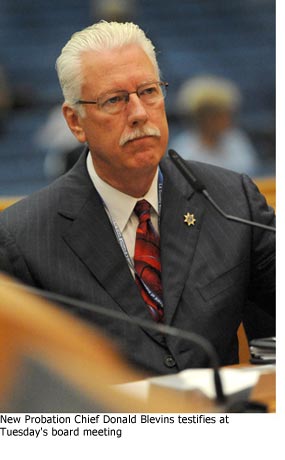 Standing along a back wall in the Board of Supervisors’ hearing room, the newly appointed chief of the Probation Department almost smiled as his bosses unanimously passed three measures aimed at restoring integrity and accountability to the troubled agency.
Standing along a back wall in the Board of Supervisors’ hearing room, the newly appointed chief of the Probation Department almost smiled as his bosses unanimously passed three measures aimed at restoring integrity and accountability to the troubled agency.
“I thought the vote was very encouraging,” said Chief Probation Officer Donald Blevins, who has little to smile about these days. “This is another example of the message I continue to get from [the Supervisors]—that we brought you in to fix a huge problem and we want to give you the tools to get the job done.”
The motions, which passed quickly and without discussion, had been tabled after Supervisor Mark Ridley-Thomas abstained from voting on them last week, leaving the short-handed board one vote short of the three needed for passage. Although the supervisor did not explain the move, the next day he called on the Justice Department to broadly oversee the Probation Department, saying the problems were too entrenched for the new management team to fix—a view not shared by his colleagues.
On Tuesday, Ridley-Thomas voted to approve the three motions. Supervisor Don Knabe was absent.
In recent weeks, the 6,000-person Probation Department has been rocked by disclosures that, among other things, employees used county credit cards to buy electronics goods that dozens of employees accused of misconduct escaped discipline because the investigations ran too long and that the department cannot fully track $79 million allocated by the Board of Supervisors largely to hire personnel.
Two of the motions passed Tuesday were co-authored by Supervisor Zev Yaroslavsky. One, written with Supervisor Michael D. Antonovich, will expand the responsibilities of the Office of Independent Review to include oversight of the Probation Department’s internal investigations. For nearly a decade, the OIR’s work has been largely confined to monitoring the operations of the Sheriff’s Department.
The second motion—this one co-authored with Supervisor Gloria Molina—directs the CEO, County Counsel, personnel officials and others to explore within 30 days how Blevins could, under Civil Service rules, begin hiring more managers from outside the Probation Department—a break with current practices.
The third motion, authored by Supervisors Antonovich and Knabe, attempts, among other things, to insure that that no employees in the future escape discipline because of unnecessarily long internal investigations and that probation officials responsible for such lapses in the past be held accountable.
In an interview, Blevins said that, thanks to the passage of the motions, he was “pretty satisfied that we have the right tools we need now.” He didn’t rule out, however, the possibility that he’ll return to the Board for help in solving future problems.
Moving forward, Blevins stressed the need for building a management team of about four to eight people, including insiders and outsiders, that can hit the ground within 60 days. “It’s important,” he said, “to have a management team that’s loyal to you.”
He said he also wants to quickly initiate discussions with the Office of Independent Review so its attorneys can start providing the kind of tough oversight that will reduce bottlenecks that have plagued the department’s internal disciplinary system. He praised a recently completed OIR study of the department’s disciplinary lapses, saying it offered “the same conclusions I would have come to.”
On Tuesday, Blevins also presented the supervisors with a status report on the management and administration of the department, focusing on areas where the department already has begun to confront deficiencies and impose tighter controls.
Blevins said, for example, that the department is now attempting to track where each of its employees currently is assigned to work. This surfaced as an embarrassing problem after probation officials were unable to tell the board exactly how the $79 million allocated for new hires had been spent.
Blevins also said in his report he is determined to increase the department’s operational and financial efficiency by making sure staffing ratios are appropriate and that the department’s network of juvenile camps are not housing charges who would benefit from less costly community-based alternatives.
Still, despite the many problems facing his department, the well-respected probation chief sounded a positive note.
“Although there are departmental practices and procedures which have developed over many years and are within a departmental culture that is by nature resistant to change,” he said, “such resistance can be overcome as many staff and managers appear to be supportive of change to improve the Department.”
Two additional reports are scheduled to be delivered to the Board of Supervisors next month. One is an assessment undertaken by Chief Deputy Cal Remington and the other is a report by county-hired consultants on the juvenile probation camps.
Posted 6/29/10
Empty VA building to house homeless vets
June 28, 2010
Vacant for nearly two decades, Building 209 on the Veterans Administration’s sprawling West L.A. property was a one-time mental health ward without a modern mission.
But thanks to $20 million pledged by Department of Veterans Affairs Secretary Eric Shinseki, the three-story, 46,000 square foot facility will get a top-to-bottom renovation and provide chronically-homeless veterans with a new home.
“Ending Veteran homelessness is one of my top priorities, and this building renovation will provide housing and take us one stop closer to achieving our goal,” Shinseki said, referring to a plan he announced last fall to end veterans’ homelessness by 2015. “No veteran should have to face the challenge of being homeless.”
Building 209 will be converted into apartments for 70 to 90 veterans who have long-standing problems with homelessness. The facility will provide not only housing, but also therapeutic services that include medical and mental health care treatment. In Los Angeles County, there are an estimated 6,540 homeless veterans.
The stucco building, built in 1945, was first used as an in-patient psychiatric facility and was later converted for out-patient care. It’s been empty since the early 1990s.
The promise of funding came during a June 16 meeting on Capitol Hill between Shinseki, Sen. Dianne Feinstein, Rep. Henry Waxman and L.A. County Supervisor Zev Yaroslavsky. At the hour-long meeting, held in Feinstein’s office, Shinseki also promised to help the officials find additional funding to convert two adjacent buildings to provide similar housing.
“I’m very encouraged by Secretary Shinseki’s pledge of $20 million to make this renovation project a reality,” Feinstein said in a joint statement with Waxman and Yaroslavsky.
“We so appreciate Secretary Shinseki’s commitment to house our homeless veterans who have already sacrificed so much for our nation,” Yaroslavsky said.
“This action will provide critical long-term therapeutic housing that is long overdue,” Waxman said.
The deal caps an arduous 6-year effort that began in 2004 after Santa Monica Mayor Bobby Shriver, then running for city council, proposed housing the homeless in empty buildings at the VA’s facility.
At the time, the Bush Administration was considering selling portions of the Veterans Administration land, including the property around Building 209, to private developers. The privatization effort failed, and Shriver and other elected officials pushed successfully to have the three buildings set aside for homeless services. In 2007, then-Veterans Affairs Secretary James Nicholson agreed to the plan.
Still, the buildings sat vacant, partly because of a failed effort by VA officials to secure funding from the non-profit sector. Last winter, Feinstein, Waxman and Yaroslavksy pushed the VA to come up with an alternative plan to fund the renovation.
Shinseki’s $20 million pledge will cover seismic retrofitting and a top to bottom overhaul.
“It’ll basically be gutting the whole darned building and redoing it,” said Ronald Norby, director of the VA Desert Pacific Healthcare Network, which covers Southern California and Southern Nevada.
The facility will be the first at the West L.A. facility to provide long-term housing plus therapeutic services for the most difficult to reach veterans, some of whom have been on the street for years.
Additional federal money will be needed to operate the facility, which could be run either by VA staffers or by a non-profit contract provider, according to VA officials.
In a statement Monday, Shriver said the Veterans Administration’s commitment was “fantastic news.” But he added: “We won’t say congratulations until the first homeless veteran is housed and receiving treatment.”
Loud work coming on 405 project
June 24, 2010
If you plan to be around the intersection of Wilshire Boulevard and the 405 on Monday, June 28, you might want to pack some extra-large earplugs. And hang on to them for nine days.
Workers on the Sepulveda Pass Widening Project, which is adding a 10-mile northbound carpool lane to the freeway, on Monday will start driving steel piles into the earth to support what will eventually be a new offramp and onramp from the 405.
The work will take place during the daytime from 7 a.m. to 3:30 p.m., with three days allotted to driving each of three steel piles. No work will take place from July 3 to July 5.
“It will be noisy,” says Kasey Shuda of Metro’s community relations, advising people to stay away from the area if they can.
Metro’s complete notice on the work, including sidewalk closures, is here.
Posted 6/24/10
Baby, you can’t drive these cars
June 24, 2010
Ah, that old car smell. Step inside the anonymous-looking Gardena warehouse and breathe it in: History. Glamour. Prestige. And a big ol’ steam-powered tractor, complete with dirt-encrusted tires, that Hollywood’s Edgar Bergen drove around his orange grove in the San Fernando Valley.
Stashed away in this unlikely location is one of the country’s most intriguing collections of 75 vintage vehicles, owned by what may seem like an equally unusual collector—the County of Los Angeles.
The county-run Natural History Museum came into possession of the cars when it parted ways with the Petersen Automotive Museum in 2007 as part of a divvy between the two. The Petersen, now a private non-profit institution, kept cars that had been given to its foundation over the years, while the Natural History Museum kept those that had been given to the county by such benefactors as Bergen’s widow, who donated the tractor.
The county collection has been largely off the general public’s radar, although experts and researchers use it heavily and individual cars have been displayed at the Natural History Museum, the Petersen and at other facilities and events.
Now the public is about to get a look. This fall, the museum plans to start offering behind-the-scenes tours one day a month at its Gardena collections facility.
Museum officials also are attempting to refine the collection’s mission—an exercise that includes deciding which vehicles are most important to keep. Their report to the Board of Supervisors is expected by the end of the month.
Will the 1963 Rolls-Royce Silver Cloud III, donated to the county by a Pasadena doctor, make the cut? How about those two rumble seat-equipped Model As? Or the gleaming black 1932 Duesenberg roadster, its imposing body designed at Pasadena’s Walter Murphy coachworks?
Museum officials won’t say which, if any, vehicles may be moving on. But their goal is to focus on vehicles that have a story to tell about Los Angeles and California—especially those that remain in authentic, unrestored condition, with their “cultural DNA intact,” in the words of John Long, the museum’s vice president for research and collections.
“A lot of our cars aren’t wonderfully polished and looking like they’re straight off the showroom floor,” he says.
Some are, of course—like a bright yellow 1927 McFarlan roadster. “It’s totally historically inaccurate, but it’s a gorgeous piece of eye candy,” says the museum’s collections manager, Beth Werling.
The current belle of the garage, however, is an exceptionally rare 1908 Pierce Great Arrow touring car made in Buffalo, N.Y., once owned by the wife of the editor of the San Francisco Examiner. It’s massive and imposing, even regal, with gold monograms on its wine-red doors.
The vehicle is said to be the only one of its kind in original, unrestored condition—something that auto connoisseurs find interesting these days, it turns out.
The Great Arrow’s been invited to participate in the Concours d’Elegance car exhibition in Pebble Beach in August, where Pierce cars will be a particular focus.
“The Concours d’Elegance is the most prestigious car show in the world right now,” Werling says. “Being invited is like being nominated for an Oscar.”
The Concours selection committee is even footing the bill for transporting the car to and from Pebble Beach. “It’s a magnificent car,” says Martin E. Button, who’s on the selection committee and whose company, Cosdel International Transportation, specializes in the import and export of collector cars from around the world.
“It is the only one that is unrestored and in original condition—which is really important…I have a 1909 Pierce Arrow that’s not nearly as rare as this.”
And one of these years—maybe this one—an unrestored car may win big at the Concours.
“We’ve never had an unrestored car win Best of Show, but everybody wants it to happen,” Button says. “We’d love to see that.”
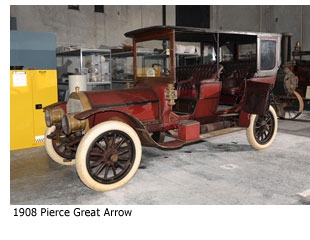 In order to have a shot at rolling over the ramp to a moment of glory in front of the Lodge at Pebble Beach, a car has to actually be drivable, which presents a bit of a problem. The Great Arrow, which was running in 1998 when it previously was exhibited at Pebble Beach as part of the Petersen’s collection, now has a gummed-up carburetor. It’s on its way to a specialty mechanic.
In order to have a shot at rolling over the ramp to a moment of glory in front of the Lodge at Pebble Beach, a car has to actually be drivable, which presents a bit of a problem. The Great Arrow, which was running in 1998 when it previously was exhibited at Pebble Beach as part of the Petersen’s collection, now has a gummed-up carburetor. It’s on its way to a specialty mechanic.
“We’re scrambling to find funding to get it up and running,” Werling says. “We’re not sending it to Pep Boys.”
Werling, who has degrees from Stanford and NYU, also manages Natural History Museum collections ranging from jewelry (“We have Pio Pico’s rosary”) to aircraft (“We have a glider and we have a bi-plane.”) Her previous professional experience with vehicles was limited to tractors at an agricultural museum in Arkansas.
“It’s been a big new world,” she says. “It’s a very complex artifact to take care of.”
As she moves through the collection, Werling points out two types of cars with California links. For some, the connection is obvious—they were made here during the city’s early 20th century burst of automotive entrepreneurial spirit. In this category are the two 1902 Tourists, for example, made by downtown L.A.’s once dominant Auto Vehicle Company.
Then there’s the second category—cars made elsewhere but that reflect something about the California people who made or used them.
Take, for example, the butter yellow 1953 Cadillac Eldorado, to be displayed as part of the museum’s multifaceted Southern California history exhibit “Under the Sun” when it debuts in 2012. The car’s design is the work of the legendary Harley Earl, who was born and raised in Hollywood and went on to fame as head of General Motors’ style department. He got his start in his father’s Earl Automotive Works in Los Angeles, going on to create showy vehicles for Silent Era film stars before Detroit lured him away.
Like the Cadillac, other vehicles have ties to an earlier Los Angeles, a time when local road races became fodder for the era’s moviemakers. The museum’s 1915 Stutz White Squadron Race Car (currently on loan to the Petersen) appeared in an early movie in which a real racecar driver, Earl Cooper, played the love interest to Mabel Normand.
A Jaguar 1954 XK-120 coupe in the collection speaks to Los Angeles’ emergence as a sports car capitol after World War II. “We had the roads that you could drive them on,” Werling says. Those images reached the rest of the country—and the world—by way of Hollywood movies. And the rest, as they say, is history.
When it comes to the stories behind the cars, it’s hard to beat the jaunty red1904 Franklin that staged one of the first cross-county road trips—with Pasadena mechanic Lester Whitman at the wheel—and later survived the San Francisco earthquake. After the quake, as fires raged, the plucky vehicle helped ferry survivors across the bay to Oakland, losing its wicker basket trunk to burning embers in the process.
Now it’s time to present those stories—and the collection as a whole—to the public.
“They’ve got some great cars down there, they really do,” says Button, of the Pebble Beach Concours d’Elegance selection committee. “You have some wonderful cars and I think they’re a real attraction. I just think it’s a real shame to have cars stashed away.”
Focusing on “preservation cars” like the Pierce Great Arrow might be a good niche to develop as the museum refines its collection. “There are no museums that do that,” Button says. “One of the sayings we have, and you can quote it, is: You can’t restore originality.”
By the way, don’t expect any cross-town rivalry from Leslie Kendall, curator of the Petersen Automotive Museum, who says he’d welcome the opening of the Natural History Museum’s collection to the public for tours.
“I can’t get enough,” Kendall says. “I love the idea that there’d be another place I could see great cars.”
Photos by Scott Harms/Los Angeles County
Posted 6/24/10
An evening with Christopher Hitchens
June 24, 2010
THIS EVENT HAS BEEN CANCELLED! For personal reasons, Christopher Hitchens has regretfully been forced to cancel his trip to Los Angeles.
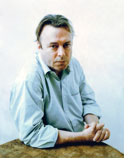 Pundit and provocateur Christopher Hitchens returns to L.A. to discuss his recently published memoir “Hitch-22” on Monday, June 28 at 8:00 PM at the Aratani/Japan America Theatre in Little Tokyo. It’s all part of the “Aloud” reading and lecture series presented by the Library Foundation of Los Angeles, supporting the city’s Public Library.
Pundit and provocateur Christopher Hitchens returns to L.A. to discuss his recently published memoir “Hitch-22” on Monday, June 28 at 8:00 PM at the Aratani/Japan America Theatre in Little Tokyo. It’s all part of the “Aloud” reading and lecture series presented by the Library Foundation of Los Angeles, supporting the city’s Public Library.
Hitchens began his political journey as an ardent socialist and budding revolutionary in the 1960s, but his commitment to human rights, even when it means supporting unpopular wars, eventually alienated him from the traditional Left. He also is known for his unyielding antipathy toward all organized religion and relentless contrarianism. A famously prolific writer, he is the author of 10 books and hundreds of articles and essays. His politics today defy conventional classification, but he has been widely praised for his wit, erudition and powerful polemical style – all of which are on full display in his frequent public appearances in the media and on stage.
The Aratani/Japan America Theatre is located at 244 South San Pedro Street in downtown Los Angeles. Order your tickets online, and here is information on parking and directions.
Posted 6/24/10
“Thurgood” comes to the Geffen Playhouse
June 24, 2010
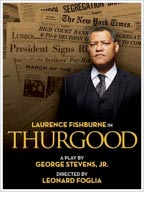 Thurgood Marshall was a towering figure in American jurisprudence, the first African American to serve on the Supreme Court. He was born in Baltimore as the son of a railway porter and steward at a whites-only country club, and grandson of a slave. Despite having graduated with honors from Pennsylvania’s Lincoln University, Marshall initially was rejected on racial grounds from entering the University of Maryland Law School. He enrolled instead at Howard University Law School, graduating first in his class in 1933. A brilliant legal career soon followed, beginning with a short stint in private practice before Marshall joined the National Association for the Advancement of Colored People (NAACP) as a staff lawyer, quickly rising by 1940 to head up the NAACP Legal Defense and Educational Fund. He went on to win 29 of the 32 cases he argued before the Supreme Court, including the landmark 1954 Brown vs. Board of Education decision that overturned the Court’s longstanding “separate but equal” doctrine dating from 1896. Appointed to the Supreme Court in 1967 by then-President Lyndon Johnson, Marshall served with distinction until his retirement in 1991. He died in 1993 at the age of 85.
Thurgood Marshall was a towering figure in American jurisprudence, the first African American to serve on the Supreme Court. He was born in Baltimore as the son of a railway porter and steward at a whites-only country club, and grandson of a slave. Despite having graduated with honors from Pennsylvania’s Lincoln University, Marshall initially was rejected on racial grounds from entering the University of Maryland Law School. He enrolled instead at Howard University Law School, graduating first in his class in 1933. A brilliant legal career soon followed, beginning with a short stint in private practice before Marshall joined the National Association for the Advancement of Colored People (NAACP) as a staff lawyer, quickly rising by 1940 to head up the NAACP Legal Defense and Educational Fund. He went on to win 29 of the 32 cases he argued before the Supreme Court, including the landmark 1954 Brown vs. Board of Education decision that overturned the Court’s longstanding “separate but equal” doctrine dating from 1896. Appointed to the Supreme Court in 1967 by then-President Lyndon Johnson, Marshall served with distinction until his retirement in 1991. He died in 1993 at the age of 85.
Laurence Fishburne brings Marshall to life once again when he recreates his Tony-nominated Broadway role for the Geffen’s new West Coast production of the George Stevens, Jr. play. At only 95 minutes in one act, it’s kid-friendly, too, offering an accessible and inspiring introduction to one of the most acclaimed and influential figures of our time. The Geffen Playhouse is located in Westwood Village at 10886 Le Conte Ave. in Westwood Village. Here’s the full rundown on all of this season’s productions, along with a seating chart and how to purchase tickets.





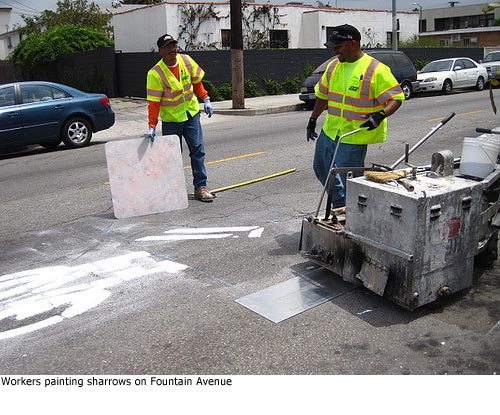
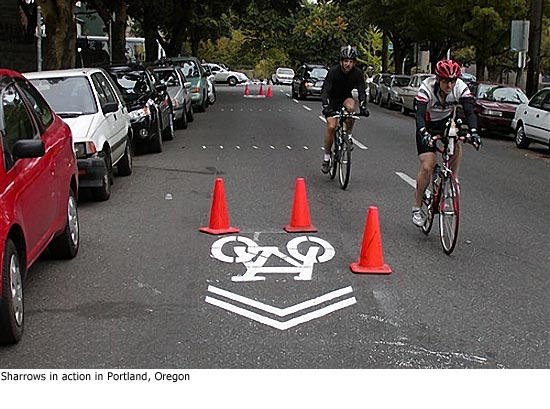
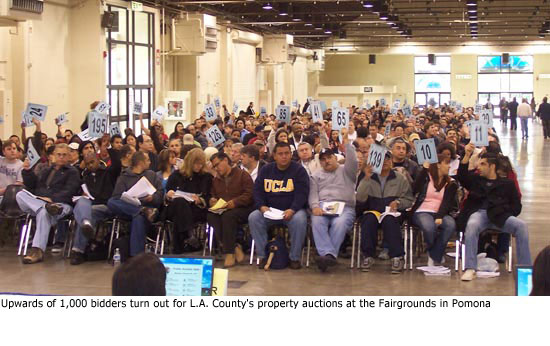
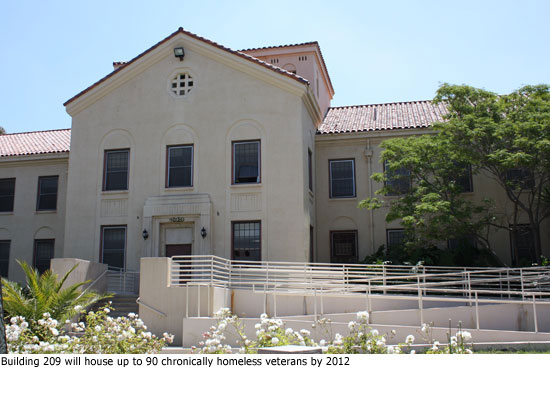
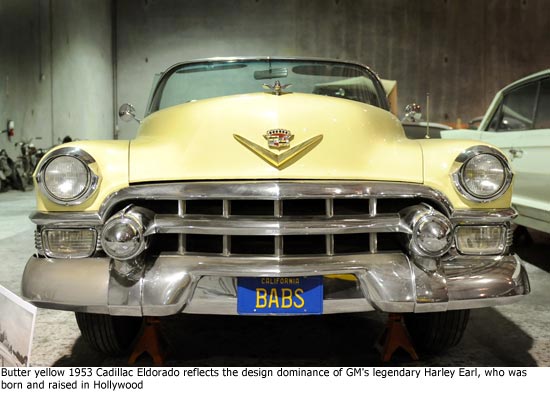
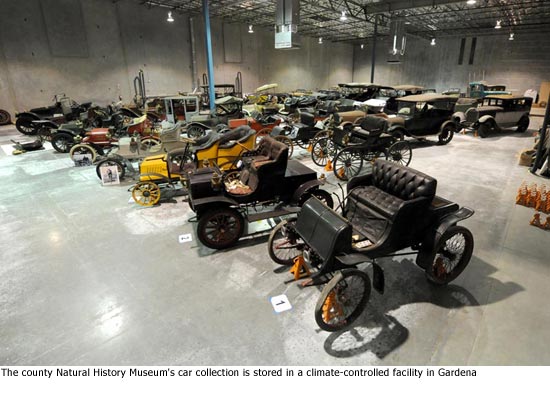




















 Check for the latest closure information
Check for the latest closure information








